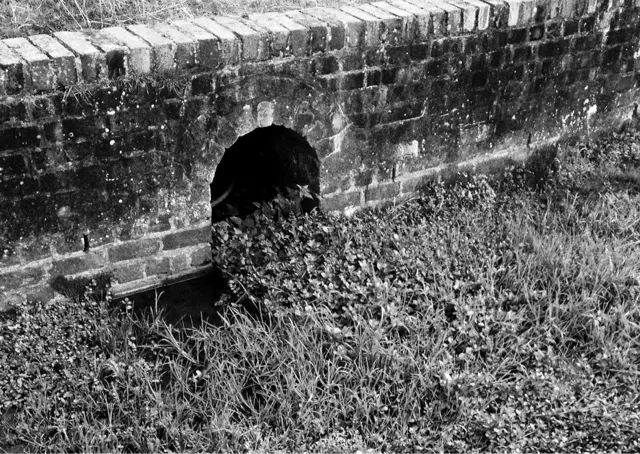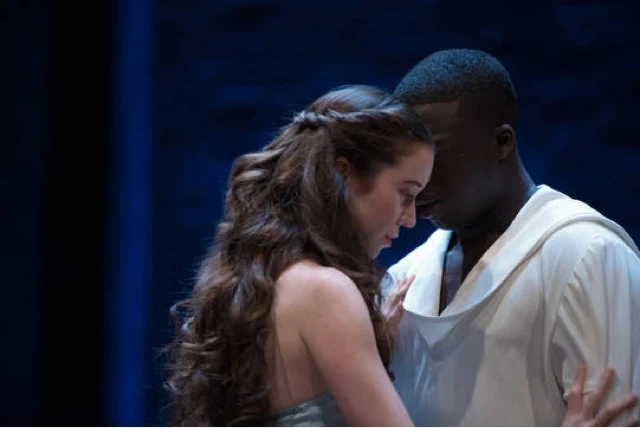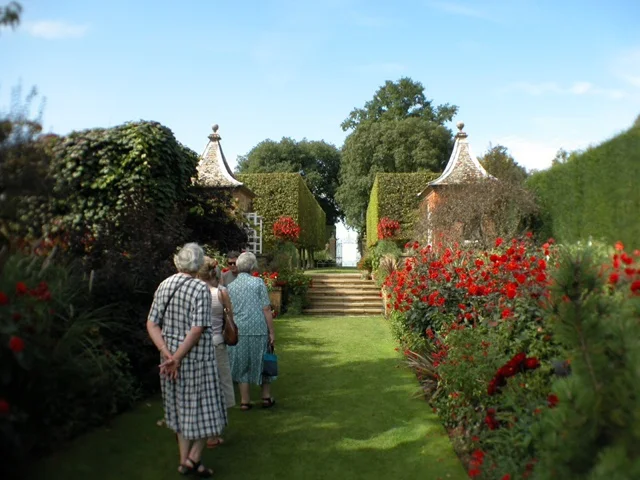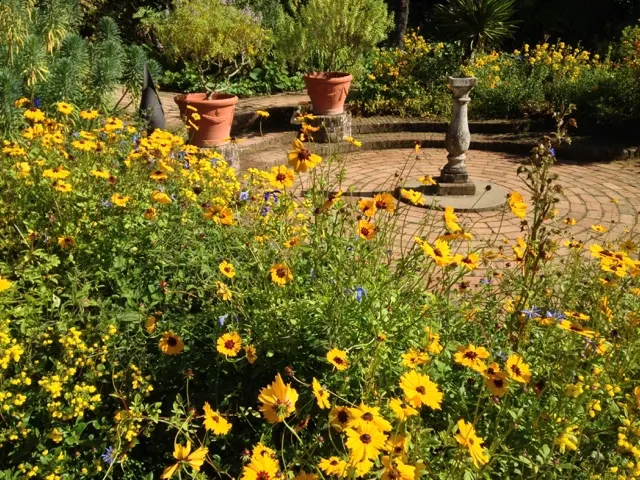The past was now a space where it was possible to seek out clues about where we had come from. And the truth? Well, the truth was now far more hazy; far less certain; and much more difficult to get a grip on. And this brought up a fundamental question: Was the past something that was just out there, waiting to be discovered; or was it a faint canvas on which we wrote down our own versions of history? In other words: Was the past something that controlled us – or did we control the past?
Derbhle Crotty (Hecuba) – photo by Paul Stuart/Design by RSC Visual Communications
Why do Thracians wear yellow pyjamas…?
Saturday, 19 September 2015
Sitting down to voice my immediately reactive thoughts, following my first viewing (of three) of
Hecuba, it suddenly seemed unfair (even though/especially as my relationship with the RSC’s press office is only currently at the wooing stage) to publish an appraisal of a play still, then, in preview – however utterly wonderful it may be; and however fully-rehearsed the RSC’s companies always appear to be – particularly given the furore over what I have come to think of as
Cucumberpatchdollgate. So, by the time you read this review, I will have been to see this gripping new drama
twice.
And, because the ‘purpose’ of this blog is more to do with me musing aloud to myself, whilst a few discerning folk (“
the two or three unfortunate wretches who may eventually read me”) accidentally eavesdrop; rather than promoting the sales of theatre tickets (a useful side-effect, perchance) – hopefully, analysing and portraying performances for posterity; rather than producing apt, pithy, poster-appropriate soundbites – I see no harm in delaying such gratification: even when a production only runs – as does this one, regrettably… – for one teensy-weensy, miniature month.
Derbhle Crotty (Hecuba) – photo by Topher McGrillis/RSC
For a change, I shall begin with the tightly-knit and outstanding cast. Derbhle Crotty is immensely powerful in the title rôle –
the snout cocked, the straight back, three thousand years of breeding in that pose – welcoming us inside her head and heart with conspiratorial ease; and presenting both her power and its loss (and the resulting perceived frailty) in a performance that is both enthralling and perturbing. Sometimes, though – and a second reading may confirm whether this is, as I suspect, a
deliberate trait: forming the cement that binds her whole; immersed, as she is, deep in a traumatic mass of familial loss –
Eighteen children I’m told – you sense, as a character, that she is holding back some of the emotions that are churning deep within her: despite her apparent forthrightness. The same, I feel, is true of cursed Cassandra –
the mad daughter, the oracle – played by Nadia Albina: who, during the summer season, repeatedly proved how strong and forthright she could be (in
Othello and
The Merchant of Venice). As Hecuba’s disowned daughter, and, eventually, only surviving child –
I am no one’s mother. No one’s – she seems somehow repressed, withheld… – although her line,
They will lie about what happened this day is the pivot on which the play both hangs and revolves.
Amy McAllister looks – and perfectly acts – half her age as courageous Polyxena (sister to Cassandra; but both physically and emotionally closer to her mother): demonstrating a youthful self-possession and sad stoicism in the face of impending (and agonizing) sacrifice –
we’re butchering her, she won’t die, a bad omen. Sadly, David Ajao – as Achilles’ son, Nepetolemus – is somewhat underused in helping evidence her coming of age; and feels a little emblematic. Chu Omambala, though, constantly brings to the stage a charismatic chill – as the egocentric Odysseus only really, I think,
hinted at by Euripides, in his
Hecabe – and is the manipulative manifestation of evil; a persuasive devil personified –
he slinks off, sly islander that he is, bandy-legged mountain man, invisible, indispensable, the men love him – his every action dismaying; his every word damnatory. (Did Homer know?) It is he who is truly responsible for Polyxena’s death. It is he who truly wields the knife he symbolically holds aloft so steadily.
In contrast, Lara Stubbs – both as ‘Hecuba’s woman’ and ‘singer’ (forcefully marking each episodic change with brilliant and thrilling music – by
Isobel Waller-Bridge – earthly, appositely, almost-wordlessly redolent of the Mediterranean and Middle East) – brings a powerful, serene presence to the proceedings: the calm eye at the centre of a whirlwind of despair and insinuated brutality. “Insinuated”, because, truly, all of the bloodshed is implied. The warning on the tickets that this is a spectacle suitable only for those “aged 12+ as contains some violence and distressing scenes” applies more, I feel, to Carr’s intense use of graphic
representations than the majority of the action: verbalizing that makes you experience the destruction of Troy and the individual Trojans with visceral intensity –
My grandson, intact except for his head, smashed off a wall, like an eggshell. This is not a play that will have you leaving the Swan with a smile on your face –
may the gods be near you when you look on this sight – but it
will make a mark, long to fade, on your soul – such as only the
best theatre can.
Amy McAllister (Polyxena) and David Ajao (Nepotolemus) – photo by Topher McGrillis/RSC
In an interview (separate to the one quoted below –
this one features in the programme notes),
Marina Carr, the play’s writer (or ‘
wright’), states that she wants the audience “to be heartbroken” when they leave the auditorium: and I would think, given the reception I witnessed tonight (apart from the two pestiferous sweet-bag-botherers directly in front of me), she would be mighty pleased.
This spectator, indeed, had his “
hardest-working muscle” stretched to breaking point several times: suffering soaring sorrow upon serial sadness. (It still aches, several days later….)
This is not to say that any vein of humour is completely absent – but what runs through it all is perhaps more of the dark kind (and therefore harder to find): tinged with occasional moments of irony, whimsy, recognition… and relief. This is tragedy topped with a capital ‘T’ – rather than a Corinthian, Doric, or Ionic one: the stage design (by Soutra Gilmour) being appositely, mesmerisingly, bare and reflective… – and with capital performances, to boot. And it is such glorious moments of adversity that reinforce each representation’s remembrance: particularly the startlingly calm, but forceful,
Luca Saraceni-Gunner as young Polydorus. (I too – like Ray Fearon’s potent, pensive, persuasive –
a mountain of a man –
Agamemnon –
wouldn’t care to meet him on the battlefield, head of his army, sixteen – such is this small boy’s innate maturity and undoubted mettle.)
Ray Fearon (Agamemnon) – photo by Topher McGrillis/RSC
Hecuba brings to life private thoughts, making the play resonate for a modern audience. Above that, the story also helps us understand what it means to live within a society, in much the same way the Greek playwrights themselves were trying to invent an idea of the world.
“In a way we’ve come full circle as we’re also trying to define a series of narratives and powerful codes by which we live.”
These huge plays, Marina believes, are about “powerful emotion that we all carry around, even though we try to sift through it because our passions are so huge. But I think they were onto something trying to define and contain the immensity of what it is to be alive.”
If I have one small criticism, it is of (equally small) portions of the play’s language. Firstly, much of the early dialogue – and the device returns later (or
seems to), albeit less noticeably, less intensely – consists of characters fluidly describing what they believe the others to have said (and done) – overlapping; cross-delivering;
ventriloquizing each other’s speech, in effect – alongside their subjective interpretation of motive and message; whilst reciting the minutiae of the monumental, monstrous carnage – perhaps each also characterizing, in turn, therefore, the rôle of the traditional ‘chorus’ (as featured in
Henry V, currently playing next door, in the
Jam Factory – and with which there are other pertinent parallels).
Although intensely enlightening – and one of the wonderful ways Carr demonstrates both the fragility of meaning and the shifting, coloured readings we all constantly employ – the rapid repetition of “he says” and “she says” quickly grates. It is a tic which, as the play gathers pace, and its richness of vocabulary expands and deepens – although then gradually, apparently, decreasing both in frequency and impact – is, to my mind, over-employed: never quite attaining the necessary unobtrusiveness that would render it more musical motif than contrived punctuation. My belief is that the number of incidences and reiterations – especially of “I say” – could be rigorously pruned; the frequency of such grammatical, prosaic thorns amongst the blossoming discourse decreased – and so much sooner. Their interpolation becomes a barrier to instant, initial immersion: as if you can hear the musical box still being wound whilst the melody begins to sing, struggling for the fluency and volume with which to drown out the rude mechanism below….
Secondly, the infrequent expletives seem superficial, and out of style – “
time out of joint” – modern, shocking superimpositions on a developed, formalistic (and singing) tenor that Carr herself states is “maybe best described as Trojan English”. It is not that I am in any way perturbed by
bad language (I use it myself all-too frequently – especially for the
momentary relief of pain…) – just that, again, such words felt, to me, unnecessary interruptions in, and obstacles to, the flow of poetry; and I am not sure, put simply, such temporary stoppages achieve anything effective or meaningful. (Strangely enough, these profanities read well in the script; and are so much less noticeable….)
Finally, there are dull – albeit brief, transitory – episodes of mundanity (such as the discussion of systems of law): which, similarly, temporarily slow the momentum, as well as risk losing, interrupting, impeding our interest. Perhaps these hiatuses are to give us chance to regain our collective breath; wipe our cumulative tears…? But such breaks in intensity, I am sure, are not really required; they could easily be excised – the effortless effusion of emotion is what pulls us on eagerly to the end (although please, please do not applaud until several extended moments of ruminative silence have passed – and slowly… – there are no awards for thinking (foolishly) that you are the first to realize the play has finished…); and there are already more ‘natural’ ebbs amongst the torrents of passion and pain that achieve these aims more readily.
Ray Fearon (Agamemnon) – photo by Topher McGrillis/RSC
In conclusion, this
is great drama –
a great drama – though, certainly, whatever my writerly quibbles; and it is directed with great aplomb by RSC Deputy Artistic Director
Erica Whyman. I would even go so far as to say that
Hecuba has the overt potential to be as perfect as such contrivances ever
can be. This is a thing of great, profound, knowing, harrowing humanity, and accompanying bleak beauty; mixed with many subtle, but relevant, contemporary resonances –
There are laws around the conduct of war. And, as much as it is tempting (almost) to say it is something of a ‘feminist’ play (no bad thing, from
my perspective) –
Society can’t run if the women are unhappy – such an utterance may far too artlessly disentangle its complexities.
However, there
are positive clues, pointers, elements, leading directly to such a conclusion: including the text’s balancing of the past
masculine mastery of myth with its fresh womanly, motherly, female perspective. Even the butch warriors, previously renowned mainly for their feats (and fates) in battle, now have hearts (and minds): they love, as well as lust; cry tears, as well as
havoc. The heroines are no longer sketchily, sweepingly “
mad, bad and dangerous to know” – which, usually, of course, in classical Greece, means dangerous for
men to know – but are fully-painted, fully-sculpted, fully-animated beings: at
least equal to those who would use and usurp them. They know – and comprehend it keenly – the pain of both blood-line and blood-letting.
As a result, the almost-two hours (no interval: as is the “classical” Greek way) runs quickly: gripping you by the throat; squeezing your chest hard; pushing you back into your seat…. Which is, of course, why I will return for more pummelling in a week’s time (and then yet again, just before it closes: once more, with captions…).
Derbhle Crotty (Hecuba) – photo by Topher McGrillis/RSC
Why you should see some productions more than once…
Saturday, 26 September 2015
I realized, after my initial (re)viewing, that this was the first play I had seen in a very long time where I had not read – or been able to read – the
text in advance. I had perused
Philip Vellacott’s beautiful, moving, intelligent 1963 translation of Euripides’ original
Hecabe (see above) – from where this post’s main title originates… – but that was really all I knew. With no surtitles to guide me, I was therefore reliant on my
rebuilt hearing aids and prolonged, surprisingly simply-achieved, concentration….
Re-reading what I now know was one of Carr’s sources (for inspiration) persuaded me, though, that my initial interpretation, nay, accusation, of ancient misogyny could not apply to Euripides himself (“
the most intensely tragic of all the poets”). As one reviewer of Vellacott’s book writes:
What makes Euripides so brilliant is his very human portrayal of the characters. You feel for them, you empathize with them, and you can anticipate their every emotional decision and thoughts of self-reflection. Hecabe… deals with the immediate aftermath of the Trojan War and the death of the Trojans… and her agony at the merciless hands of the Greeks (including Odysseus, whom we see here as very severe and inhumane, in contrast to his central heroic role in The Odyssey) make her suffering tragic beyond words….
I would suggest this book simply for the mastery of Euripides and his psychological dimension in human tragedy. Just because it is ‘ancient’ literature and a translation of the old Greek, does not in any way detract it from being so relevant and significant to the modern world. Raw human emotions….
In her introduction, Carr writes:
I always thought Hecuba got an extremely bad press. Rightly or wrongly I never agreed with the verdict on her. This play is an attempt to reexamine and, in part, redeem a great and tragic queen. History, as they say, is written by the winners. Sometimes I think myths are too…. This is my attempt to show her in another light, how she suffered, what she might have felt and how she may have reacted.
And I’m sure she’s succeeded. However, my earlier reservations about the famed Queen of Troy – from a second viewing – “that she is holding back some of the emotions that are churning deep within her” – were confirmed. This, I am also sure, though – this is deliberate. She is accused of arrogance many times – the haughty sheen – but such a mien, I believe, is the portrayed consequence of royalty; and all that such a word means for those who bear it. There are expectations to be fulfilled; as well as expectations to hold – Did no one think to bring provisions? Must I think of everything? And, even after finally discovering that her son, Polydorus, is dead – as Agamemnon says – She’s nerve and bone but still carries about her a kind of horrific grace. There’s still that sense of entitlement. You thought Troy was untouchable. You thought your gilded life would go on for ever – says Cassandra: Nadia Albina now unleashed; at full tilt – and all the better for it.
Nadia Albina (Cassandra) – photo by Topher McGrillis/RSC
Agamemnon –
this terror of the Aegean, this monster from Mycenae – is also trapped by the
greatness thrust upon him. He was not born to this – to rule – but to
fight. He is a warrior; and he is
trapped by this ‘new’ greatness and its accompanying expectations –
I’m… don’t know what I am. He is the one, therefore, who bares his heart completely – Ray Fearon also stronger, even more intense, more fluent. There is no shield, no mask, can stifle that great roar –
Only three things matter, Odysseus. Food. Sex. Winning Wars.
Chu Omambala (Odysseus) – photo by Topher McGrillis/RSC
And perhaps I was too cruel about that man, Odysseus. Less “devil”, perhaps; more
Machevill. Even
he has a heart in there: under that grey tunic. Somewhere.
This is hard. I’m not made of stone. I want to go home, never to have set eyes on Troy.
And I didn’t mention Edmund Kingsley’s tragic, subtle, soul-rending, pleading Polymestor at all. He is simply another pawn on a predestined board of chess – You played the double game, Polymestor, and your sons paid the price. And he knows it. He knows that whatever he does will come back to hurt him – but this is war.
Ray Fearon (Agamemnon) – photo by Topher McGrillis/RSC
I can take any empty space and call it a bare stage. A man walks across this empty space, whilst someone else is watching him, and this is all that is needed for an act of theatre to be engaged.
In my initial review, I stated that “the stage design [is] appositely, mesmerisingly, bare and reflective” – but didn’t expand on this. (To be honest, I think you need to experience it ‘in the flesh’ to appreciate the cohesive and sculptural qualities of Soutra Gilmour’s design; its dynamic hints of landscape and fortification; what lies beyond and beneath….) What did occur to me, though – during
this “pummelling”, this immersion – was that this reflectiveness can be seen in the tensions, the divisions that so quietly delineate the play: whether it is the deceptively-simple mirrored set itself, with its evidently-plain, scene-stealing, crucial, matt
cathedra –
The great sea god himself made this throne… dragged it up from the sea floor on his shoulders. Placed it on the founding stone and Troy began – and the partitions, the ruptures which emerge in the rear, evocative, mountain-like ‘
wall’ – the colour-conscious casting; the rich dark-sea to pale-sky
turquoise dress of the (
Turkish) royal Trojan women, versus the monochrome, utilitarian, battle-ready outfits of the Grecian warriors; the intrigue of the almost whispered sentiment, followed by the sonorous declamatory anger – or even the
Caravaggio-like use of highlight and
negative space (“
putting the oscuro into chiaroscuro” – the lighting – designed by Charles Balfour – and choreography – movement by Ayse Tashkiran – come together as something balletic, and yet sculptural). Ancient plays against modern; the tribes of as-yet-unformed Greece squabble amongst themselves; and the complex, descriptive, speech and machinations contrast forcefully with the dearth of props, costume and scenic changes. The words and actions are simply enough… – “this is all that is needed”.
Derbhle Crotty (Hecuba) and Ray Fearon (Agamemnon) – photo by Topher McGrillis/RSC
So, to finish: whether you get more from “an act of theatre”, the second time, depends, I suppose, on what it means to you – entertainment; a simple way to pass the time; or as a work of art. To me, drama is the latter. The longer I stand in front of a Rembrandt: the more I see; the more it speaks to me. Repeated hearings of Elgar’s Violin Concerto have the same effect – it drills even further into my soul. I can read the score and cry a small tear or two. To hear it, though, will make me sob with my entire being. I will be heartbroken….






































